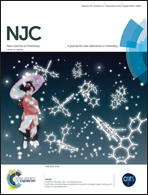Polar Diels–Alder reaction of isoprene toward 2-bromocyclobutenone followed by a subsequent sodium hydroxide-assisted ring contraction reaction. A regio- and stereoselectivity and molecular mechanism study using DFT
Abstract
The polar Diels–Alder (P-DA) reaction of isoprene, diene D10, toward 2-bromocyclobutenone, dienophile Dph4, in the presence of chloroform was theoretically studied using DFT methods at the MPWB1K/6-311G(d,p) level. Calculated relative Gibbs free energies associated with the four feasible reactive channels indicate that this P-DA cycloaddition takes place via C1–C5 regioselectivity and in a moderately endo-stereoselective manner, furnishing a formal [4+2] endo cycloadduct CA1n in excellent agreement with experimental outcomes. In the considered P-DA reaction, while C1–C5 regioselectivity can be explained using calculated Parr functions at the interacting sites of reagents, the moderately endo stereoselectivity is related to the favorable electrostatic interaction that appears in the endo-zwitterionic transition state TS1n as a consequence of the global electron density transfer (GEDT) that takes place during this polar reaction. In addition, the presence of the bulky bromine atom on Dph4 can destabilize the exoTS1x, acting as another important factor in the predominance of the endo stereoisomeric channel over the exo one. An electron localization function (ELF) topological analysis of the bonding changes during the investigated P-DA reaction supports a non-concerted, two-stage, one-step molecular mechanism in which the formation of a second C4–C6 single bond takes place after the almost complete formation of the first C1–C5 one. Moreover, the subsequent sodium hydroxide-assisted ring contraction reaction in the presence of acetonitrile converts generated CA1n into the final product, carane13, via a stepwise Favorskii process.


 Please wait while we load your content...
Please wait while we load your content...